WHAT IS IT?
WaJEi is a Japanese-English / English-Japanese dictionary program, written in Java, that allows:
- English to Japanese lookups
- Japanese to English lookups phonetically (by kana)
- Kanji lookups
- Japanese to English word lookups by kanji - using radicals to select the kanji, and looking up the word by where in the word the kanji appears (reverse lookup).
- Jumping directly to a Kanji lookup by selecting a kanji in a displayed word.
- Flash card drill of randomly selected words from the dictionary file.
WaJEi contains its own fonts, and does not rely on a Japanese font being installed on your system.
WaJEi uses Jim Breen's
edict and kanjidict dictionary files.
Both are available at the Monash Nihongo ftp archive.
WaJEi includes versions of kanjidic, but you must get edict
from the above site (see INSTALLING IT below). Also please take a look at
the kanjidic.doc file (included with WaJEi or available here), as it contains important licensing information.
WaJEi has been (and is being) designed to be used on the Sharp Zaurus SL-5500,
but should be runnable with any Java 1.1 or higher JVM. The focus on the Zaurus has some implications,
however, and makes WaJEi behave differently than other software designed for a desktop PC:
- WaJEi fills the screen by default, though it can be resized. You can also pass in window dimensions as startup parameters.
- GUI elements, particularly in the kanji lookup screen, react to one mouse click (or stencil touch),
rather than a double click. To move focus to a section of the screen, you must click (or tap) on a blank
(or non-reactivea) area of that section
- Scrolling through display elements that are larger than the screen is done by using the arrow keys (or directional pad),
rather than with scrollbars, which take up valuable real estate on a PDA, in addition to being awkward for either left or
right handers, depending on which side of the screen they occupy.
- Future work will focus on making it memory-effecient. However, I still want to include distribute it with its own protable
fonts, since installing fonts can be such a pain. In fact, I still am unsure how to make the default JVM (Jeode) on the Zaurus use a newly-installed font. If somebody has figured that out, please let me know.
WaJEi uses and is based on classes from John Howard Palevich's
JJReader. JJReader is currently not available for download at his site. His JJDict program, which uses the same dictionary classes (but not the display classes)
is available at the Monash Nihongo FTP archive here.
Included with this code are font files used, among other places, in
Jim Breen's DOS-based JDIC program. Zip files with some of these fonts are
also avilable at the Monash ftp site. Please take a look at the fontfile.doc
file distributed with WaJEi for a history of these files.
WaJEi also has elements based on code from Todd David Rudick's
JavaDict program. In particular, I adapted his code for translating roman character input into kana. I also use and adapted his sorted kanjidic file.
INSTALLING IT
Zip file
Unzip wajei.zip into your favorite directory. Obtain the
dictionary file "edict" and the index file "edict.jdx"
from the EDICT Project at the Monash Nihongo FTP archive:
http://ftp.cc.monash.edu.au/pub/nihongo/00INDEX.html
or (ftp://ftp.cc.monash.edu.au/pub/nihongo/)
The EDICT Project Home Page is at:
http://www.csse.monash.edu.au/~jwb/edict.html
To make things more convenient, you can put the edict files in the directory to which you unzipped the archive -
the same directory that contains the wajei.jar file. Otherwise, you will be asked to find them by the program.
Ipkg file
The ipkg file format is a package format used by the Zaurus to install software packages. You can install the wajei ipkg file (with the filename ending in ".ipk") on your Zaurus in the same way you would install any other software package.
Once again, obtain the edict and edict.jdx files and upload them to your Zaurus.
If you like, you can find the directory where the wajei.jar file was installed and put the "edict" and "edict.jdx" files there.
For example, if you installed it on a compact flash card (like I do), you would put the edict files in the folder "/mnt/cf/QtPalmtop/java/".
Otherwise, you can find the edict files from within the WaJEi program.
You can explore the Zaurus file system and move files around with Sharp's File Manager program, available here.
Building from the latest source in CVS
Install Ant. Download this build file. Put it
into an empty directory. Go to that directory and type "ant".
This uses a shell script "ipkg-build.sh" to build an ipkg file, so
you'll need to run it in a Unix-like environment. If you're on Windows and need a Unix-like environment, try Knoppix. Or, if you don't care about building an ipkg file, type "ant noipkg" to skip that step.
The ipkg-build.sh script was written by Carl Worth . Ant should grab it from CVS during the build, but it is also available here at www.zauruszone.com
USING IT
Start it up |
Fire up your Java 1.1 or better JVM and run WaJEi, using wajei.jar as your classpath:
java -cp wajei.jar WaJEi
When I'm running it on my desktop, I usually pass in parameters to make a window 400 pixels wide and 600 pixels tall. It gives a smiliar look to the way it runs in the Zaurus, but withmore room:
java -cp wajei.jar WaJEi 400 600
Or of course, if you've installed it on your Zaurus, simply select the lovely WaJEi logo in your Jeode tab.
Here is the opening screen. You can return to this screen at any time by choosing "Help -> About" from the menu.
If you did not put the edict files in the same directory as the jar, or you have not set the edict file yet,
you will see seomthing different. Please refer to the edict file section below.
| 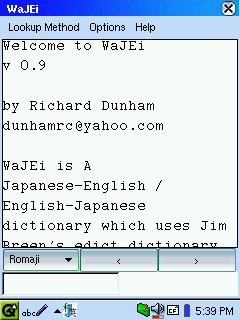 |
At the top you can see three menus in the menu bar. First is the "Lookup Method" menu, which
allows you to switch between four different screens. "Phonetic" is the screen you see at first. It's where you perform English to Japanese and Japanese to English phonetic lookups.Selecting "By Kanji" will take you to the kanji lookup screen. The "Flash Card" screen allows you to drill yourself on randomly selected words from the edict dictionary file.
The "Debug" screen is something I added to let me play around with indexes so I could figure out how the "jdx" file worked with the edict file. One of my "TODO"s is to build a utility to tune the index file so that it's optimized for reverse lookups. right now it's optimized for someone typing in part of a word, including multiple kanji. It's not tuned for selecting words based on the position of a single kanji.
|
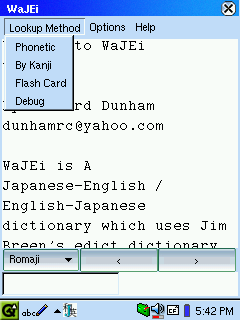
|
|
Next is the Options menu. The first item allows you to set the edict file (again, see the edict file section below.) Next you can choose whether you want an exact match search or a search for any word starting with what you've typed in. so you can shorten the results for a search on "asp" to only include those about the snake, or you can include entries with the word "asphalt". Last is an option that allows you to search the results of a previous search. If your lookup of "beach" returned too many results, and you want to narrow it down to entries containing both "beach" and "house", turn this option on. Remember to turn it off when you no longer want it!
|
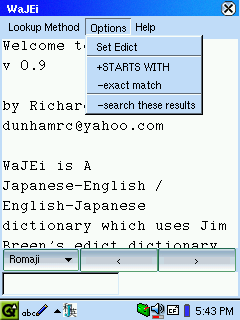 |
Finally is the
Help menu, which allows you to return to this startup screen.
Underneath the menu bar, and taking up most of the real estate, is the results view. Click or tap on this to give it focus, then you
can scroll through it using the arrow keys or directional pad. Underneath this is a drop-down list on the left, which allows you to
switch between entering roman characers, or Romaji, and Japanese phonetic characters or kana, either Hiragana or Katakana. To the
right of the drop down are two arrow buttons. These are used for scrolling through search results. WaJEi will only display 10 dictionary entries at a time. The right-pointing button will take you to the next ten results, and the left pointing arrow will take you to the previous ten results. On the bottom left is the text entry box. Click or tap here and start typing to enter a search string.
To the right of that is the search display. Here is where the program will display its interpretation of what you've typed, depending on whether
you had Romaji, Hiragana, or Katakana selected in the drop down box.
|
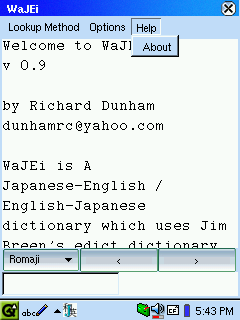 |
English to Japanese lookups |
From the menubar at the top, select "Lookup Method", then "Phonetic" to get to this screen.
Select "Romaji" from the drop down list at the bottom of the screen, and type into the entry box on the bottom left.
Your search string will appear in the box on the bottom right. Note that you can combine Romaji and Kana in the same search
(which is sometimes useful). |
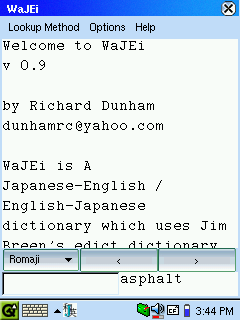 |
|
Hit Enter and this is what you get. You can scroll through the results with the arrow keys or directional pad. |
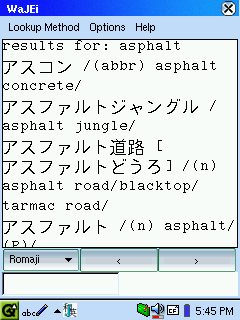 |
Japanese to English lookups - phonetically (by kana) |
From the menu bar at the top, select "Lookup Method" and then "Phonetic". Choose Hiragana from the drop
down. Actually, the Katakana option is superfluous, since the program will treat Hiragana and Katakana the same in its search.
Type in the entry box on the bottom left, and kana will appear in the box on the bottom right. |
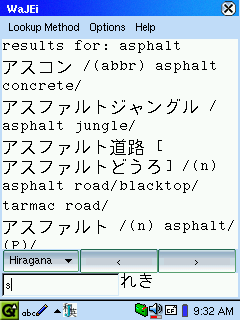 |
| Here we'll look up "rekisei". |
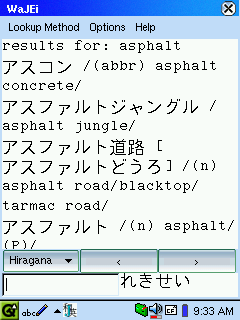 |
| After we hit Enter this is what we see. The default method for phonetic Japanese to English search is to
matches any words that begin with the search string. Therefore, searching for a short word may give more results thatn you need. This was a problem in earlier versions, because the program would wait until it had compiled the complete list results before displaying it. But starting with version 0.9, the program only displays ten results at a time. If you are looking for an exact match, it will probably show up near the beginning of the results. But, if you want to be sure, you can turn on the 'exact match' option in the "Options" drop-down menu.
|
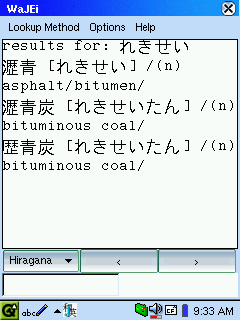 |
Japanese to English lookups - by kanji |
From the menubar at the top, select "Lookup Method", then "By Kanji", and this is what you'll see. The
screen is divided into four elements: at the top is a list of radicals. The numerals indicate the number of strokes. You can see that
the radicals are sorted by stroke count. Below this is the kanji display area. Select a radical by clicking on or tapping it, and all
kanji for that radical will appear where you see the words "kanji list here". Again, they will be sorted by stroke count.
At the bottom of the screen, where it says "kanji result here", is where information will appear for a selected kanji, and from which you can search for words containing that kanji.
Read on, and I think it will become clear. |
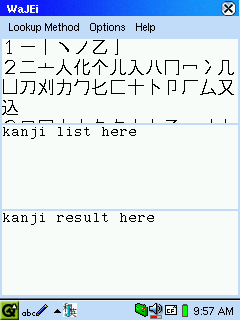 |
Touch a blank space or a number in the top third of the screen to give it focus. You can now scroll through the list of radicals using the arrow keys or the directional pad. Note again that the radicals are sorted by stroke count. |
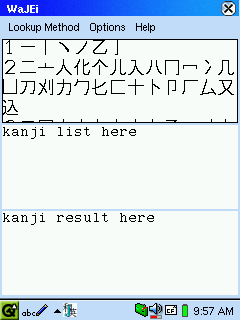 |
Click on (or tap) a radical and a list of all kanji for that radical will appear in the middle third of
the screen. Here we have clicked on the last radical in the list of radicals with six strokes. The kanji list begins with the number
of the radical, preceded by "B" (for "bushu", or "radical"). We have chosen radical number 146. Then all kanji for that radical are
listed, sorted again by stroke count. You can see that there are two kanji with six strokes, one kanji with nine strokes, etc. Since
the kanji list has focus, indicated by the box around it, you can scroll through it with the arrow keys or directional pad to find the
kanji you want. |
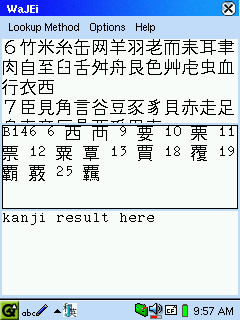 |
Click on or tap the kanji you want to use for your search. Here we have clicked on the only nine-stroke kanji for radical number 146. At the bottom of the screen is displayed first the kanji itself, then its ON and KUN readings, and its meanings. If the kanji has any nanori, or redings used only in proper names, those are displayed next. |
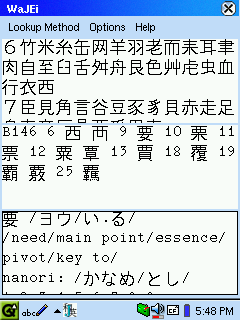 |
| Now scroll down a little in the kanji result view at the bottom, and you'll see a line with a list of numbers 1 through 9. These are for searching for words with this kanji in a certain position. To search for words with this kanji in the third position, tap or click on the number "3".
|
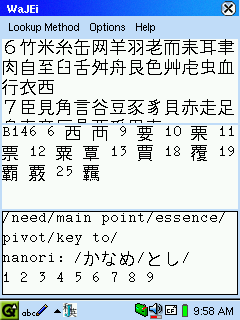 |
| And this is what we get. Notice that at the top of the screen the program tells us what we searched for.
|
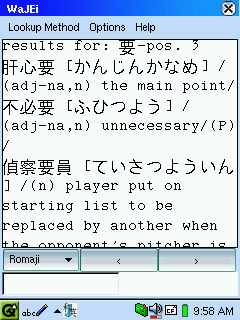 |
Setting the Edict file |
| If you did not place the edict dictionary file and edict.jdx index file in the same directory as the sagsu.jar file,
then this is what you'll see when the program starts - an error message telling telling you that the program cannot find the edict
files. You will also see this if you try to do a phonetic lookup and no edict file has been set. |
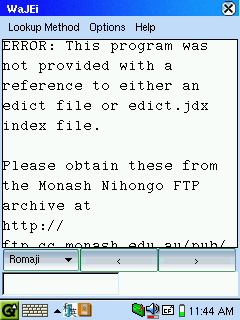 |
| To set the edict file, choose "Options -> Set Edict" from the menu. A file dialog will appear. |
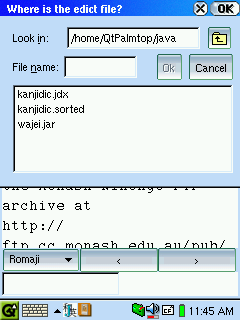 |
| Navigate through the file system and fing the edict file with the file dialog. Note that the edict.jdx file must be
in the same directory. |
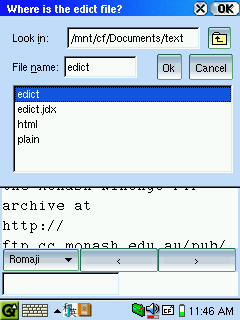 |
| If you do not choose an edict file, or you choose an edict file with no edict.jdx file in the same directory, you will
see this error message. The edict file has nont been set, and you will still see an error message if you try any lookups. |
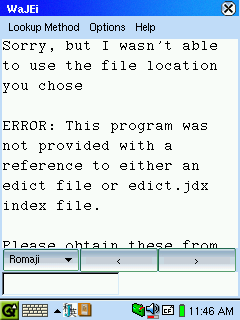 |
If everything went well you will a message like this. The edict file has been set, and it has been stored in a properties
file. You can now perform lookups, and you do not need to set the edict file again, even if you exit and retart the program.
However, please note that WaJEi first checks the execution directory before referring to the properties file for
the location of the edict files. So if you have edict files in the same directory as wajei.jar, and you want to update your edict
files, or use different edict files, make sure that you either replace the edict files in the wajei.jar directory with the new files,
or delete the old files before setting the new files from within the WaJEi program.
|
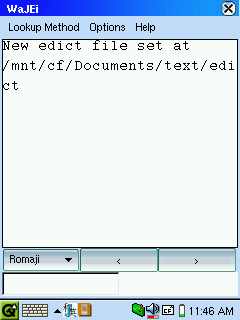 |
WHO WROTE IT?
Of course, this program wouldn't work without the dictionary files created
by Jim Breen.
As stated above in the what is it section, most of the hard work in the code was done by
John Howard Palevich and Todd David Rudick. If you find this useful, most of
the credit belongs to them.
The new stuff was written by Richard Dunham. If you find bugs or problems,
contact him. He can be reached at:
d u n h a m r c @ y a h o o . c o m
(email address slightly obfuscated to confound spam web crawlers)
COPYRIGHT STUFF
Jack Palevich's JJReader and it's classes are
Copyright (c) 1996 Palevich-Chen Industries, Inc. All Rights Reserved.
see copyright notice at head of file Edict.java.
Todd David Rudick's JavaDict program is
Copyright (C) 1997 Todd David Rudick under the GPL.
Please see kanjidic.doc for license information on the kanjidic file.
Please see fontfiles.doc for information on the font files distributed
with this program.
This program is copyright (c) 2002 Richard Dunham under the GPL.
This program is free software; you can redistribute it and/or modify
it under the terms of the GNU General Public License as published by
the Free Software Foundation; either version 2 of the License, or
(at your option) any later version.
This program is distributed in the hope that it will be useful,
but WITHOUT ANY WARRANTY; without even the implied warranty of
MERCHANTABILITY or FITNESS FOR A PARTICULAR PURPOSE. See the
GNU General Public License for more details.
You should have received a copy of the GNU General Public License
along with this program; if not, write to the Free Software
Foundation, Inc., 675 Mass Ave, Cambridge, MA 02139, USA.
VERSION INFORMATION
0.9
As you would expect from a period of several months since the last release, this has a lot of changes. In addition to new features, I made some changes to improve both actual and perceived speed. Not only do the searches seem to go faster to the user because of the 10-at-atime paging, but code optimizations have improved the actual startup time.
- Redesign of search to use the Observer pattern.
- Added Kanjidic information and redid the way the user performs reverse lookups.
- Changed search results display to page through results ten at a time.
- Added 'exact match' or 'start with' search options for phonetic search
- Added an option to 'Search within these results' for Boolean AND searches.
- Ran code through memory usage analyzer, and made changes for optimization - for example, the Font object is now a singleton.
- Added Flash Card screen
- Added debug screen to play with indexes
0.8.1
- Extended to kanji lookup the display of results using a collection of EdictEntry
objects rather than one long String.
- Corrected bug - results display position was not reset between searches
- added support for specifiying window size on command line
v0.8
- In an attempt to conserve memory, I changed the way results were returned. Instead of
returning one big String, results are now returned as an array of 'EdictEntry' objects,
each of which creates a String repressentation of that dictionay entry only when it needs to be displayed,
i.e. the user scrolls through the results to a point where that entry would appear.
- Changed the name of the software to WaJEi, since I was informed that
there is already a free software project named "Sagasu"- it's a GNOME tool
for finding strings in files. The home page is here.
v 0.7
- Fixed right justification issues
- com.pansophocope.wajei.sagasu.awt.TextCanvas: refactored getCharAt and paintWithPortableFont: moved
right justification logic which was duplicated in both
methods to its own method: rightJustify(Point currentPosition, int i)
- Modified input so that double n "nn" produces kana "n" without
anticipating another syllable starting with "n"
- com.pansophoscope.wajei.sagau.NyuuRyoku: keyTyped() and flushEntry() methods
- added line to romkana.utf
- Added "Help -> About" menu item which shows startup notice screen
- SagasuAWT: changed constructor and actionPerformed() method
- Changed startup behavior to:
- look for edict file in execution directory
- check the properties file for edict file location
- validate existence of edict files at location from properties file
- if these fail, display error message prompting
user to set edict from menu
- SagasuAWT: added methods getEdictFile(), isEdictFileThere(). modified constructor
- added file sagasu.properties
- Added "Options -> Set Edict" menu item to set edict file location
- SagasuAWT: added launchDialog() method, modified actionPerformed() method
- SagasuAWT, com.pansophoscope.wajei.kanjiru.awt.KanjiruPanel, com.pansophoscope.wajei.sagasu.awt.KanjiList:
added getters and setters for Edict to make it easy to cascade edict reset
- Added error handling behavior in lookups - if there is no edict,
display error message prompting user to set edict from menu
- SagasuAWT: modified actionPerformed()
- com.pansophoscope.wajei.sagasu.awt.KanjiList: modified mousePressed
- com.pansophoscope.wajei.sagasu.ResultsView: added static final String ERROR_BAD_EDICT
- Changed menu labels to be more self-explanatory:
- "Switch" changed to "Lookup Method"
- "Sagasu" changed to "Phonetic"
- "Kanjiru" changed to "By Kanji"
- SagasuAWT: modified constructor
v 0.6
- Packaged into jar. It takes a little longer to start on my Zaurus, but
the install size on the Zaurus is less than half of what the uncompressed classes and resources used to be.
And since I removed the sources and other files from the ipkg, it's less than a third of
what the total install size used to be.
This required changing the way that classes retrieved resources -
instead of using com.palevich.util.Resource and java.io.File, they now use
Class.getResourceAsStream. Classes modified:
- com.palevich.japanese.CodeUtil: removed reference to com.palevich.util.Resource and
replaced with call to Class.getResourceAsStream
- com.palevich.japanese.display.awt.FontImp: added a constructor which takes an
InputStream instead of a File
- com.palevich.japanese.display.awt.JFont: uses new FontImp constructor which takes InputStream instead
of File.
- com.palevich.util.Resource: removed
- com.pansophoscope.wajei.sagasu.kanjiru.awt.KanjiruPanel: use Class.getResourceAsStream instead of FileInputStream to
read kanjidic files
- com.pansophoscope.wajei.sagasu.NyuuRyoku: use Class.getResourceAsStream instead of FileInputStream to
read romkana.utf file
- Now using Ant to build
v 0.5
- fixed a bug which prevented the user from selecting a radical that
appeared as the first on a newline
this involved tweaking the method
com.pansophoscope.wajei.sagasu.awt.TextCanvas.getCharAt(int x, int y)
- added border to TextCanvas to indicate whether it has focus. This makes
Kanjiru (the kanji lookup) a little easier on the eyes
this involved adding a line to the method
com.pansophoscope.wajei.sagasu.awt.TextCanvas.paint(Graphics g)
- fixed a bug which made the user scroll back to the beginning of a kanji
list or word list after selecting a new radical or kanji, if she had scrolled
down in the previously displayed list
this involved changing
com.pansophoscope.wajei.sagasu.awt.TextCanvas.setText(String newText)
so that it resets the offsets when called
also, deleted setXOffset() and xsetYOffset() calls in
SagasuAWT.actionPerformed(ActionEvent evt)
since they were unnecessary
- added version number to startup notice
v 0.4
- published to SourceForge!
- added position drop down list to Kanjiru for reverse lookup
v 0.3
- added Kanjiru panel for lookup by kanji
v 0.2
added right-justificaion to TextCanvas, so users do not have to scroll right
to read definitions
v 0.1
- cleaned it up a bit
- added readme / GPL notice at startup




















